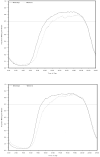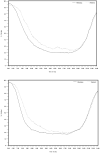Self-Reported and objectively measured physical activity among a cohort of postpartum women: the PIN Postpartum Study
- PMID: 22232505
- PMCID: PMC3257811
- DOI: 10.1123/jpah.9.1.5
Self-Reported and objectively measured physical activity among a cohort of postpartum women: the PIN Postpartum Study
Abstract
Background: Few studies measure physical activity objectively or at multiple time points during postpartum. We describe physical activity at 3- and 12-months postpartum among a cohort of women using both self-reported and objective measures.
Methods: In total, 181 women completed the 3-month postpartum measures, and 204 women completed the 12-month postpartum measures. Participants wore an ActiGraph accelerometer for 1 week and completed in-home interviews that included questions on physical activity. A cohort of 80 women participated at both time points. Poisson regression models were used to determine whether physical activity differed over time for the cohort.
Results: For the cohort, average counts/minute were 364 at 3-months postpartum and 394 at 12-months postpartum. At both time periods for the cohort, vigorous activity averaged 1 to 3 minutes/day, and moderate activity averaged 16 minutes/day. Sedentary time averaged 9.3 hours at 3-months postpartum and 8.8 hours at 12-months postpartum, out of a 19-hour day. Average counts/minute increased and sedentary behavior declined from 3- to 12-months postpartum.
Conclusion: Interventions are needed to help women integrate more moderate to vigorous physical activity and to capitalize on the improvements in sedentary behavior that occur during postpartum.
Figures



Similar articles
-
Changes in physical activity among postpartum overweight and obese women: results from the KAN-DO Study.Women Health. 2013;53(3):317-34. doi: 10.1080/03630242.2013.769482. Women Health. 2013. PMID: 23705761 Free PMC article.
-
Early postpartum physical activity and pelvic floor support and symptoms 1 year postpartum.Am J Obstet Gynecol. 2021 Feb;224(2):193.e1-193.e19. doi: 10.1016/j.ajog.2020.08.033. Epub 2020 Aug 14. Am J Obstet Gynecol. 2021. PMID: 32798462 Free PMC article.
-
Prevalence and correlates of objectively measured physical activity and sedentary behavior among US pregnant women.Prev Med. 2011 Jul-Aug;53(1-2):39-43. doi: 10.1016/j.ypmed.2011.04.014. Epub 2011 May 4. Prev Med. 2011. PMID: 21575654
-
Objectively measured patterns of sedentary time and physical activity in young adults of the Raine study cohort.Int J Behav Nutr Phys Act. 2016 Mar 24;13:41. doi: 10.1186/s12966-016-0363-0. Int J Behav Nutr Phys Act. 2016. PMID: 27009327 Free PMC article.
-
Longitudinal Analysis of Patterns and Correlates of Physical Activity and Sedentary Behavior in Women From Preconception to Postpartum: The Singapore Preconception Study of Long-Term Maternal and Child Outcomes Cohort.J Phys Act Health. 2023 May 5;20(9):850-859. doi: 10.1123/jpah.2022-0642. Print 2023 Sep 1. J Phys Act Health. 2023. PMID: 37146982
Cited by
-
Physical Activity and Body Composition in Children and Their Mothers According to Mother's Gestational Diabetes Risk: A Seven-Year Follow-Up Study.Medicina (Kaunas). 2019 Sep 25;55(10):635. doi: 10.3390/medicina55100635. Medicina (Kaunas). 2019. PMID: 31557895 Free PMC article. Clinical Trial.
-
Physical Activity Participation of Black and White Women during the First Year Postpartum: Results and Study Recruitment Strategies.Healthcare (Basel). 2023 Sep 26;11(19):2625. doi: 10.3390/healthcare11192625. Healthcare (Basel). 2023. PMID: 37830662 Free PMC article.
-
Maternal Adiposity and Energy Balance After Normotensive and Preeclamptic Pregnancies.J Clin Endocrinol Metab. 2021 Jul 13;106(8):e2941-e2952. doi: 10.1210/clinem/dgab223. J Clin Endocrinol Metab. 2021. PMID: 33824990 Free PMC article.
-
Physical activity in the early postpartum period in primiparous women.J Sci Med Sport. 2021 Nov;24(11):1149-1154. doi: 10.1016/j.jsams.2021.06.009. Epub 2021 Jun 21. J Sci Med Sport. 2021. PMID: 34244085 Free PMC article.
-
How Active Are Women in the First Year of Motherhood? A Systematic Review of Device-Measured Physical Activity.Scand J Med Sci Sports. 2025 Aug;35(8):e70108. doi: 10.1111/sms.70108. Scand J Med Sci Sports. 2025. PMID: 40741718 Free PMC article.
References
-
- Larson-Meyer DE. Effect of postpartum exercise on mothers and their offspring: a review of the literature. Obes Res. 2002 Aug;10(8):841–853. - PubMed
-
- Siega-Riz AM, Viswanathan M, Moos MK, et al. A systematic review of outcomes of maternal weight gain according to the Institute of Medicine recommendations: birthweight, fetal growth, and postpartum weight retention. Am J Obstet Gynecol. 2009 Oct;201(4):339, e331–314. - PubMed
-
- Pivarnik JM, Chambliss H, Clapp J, III, et al. Impact of physical activity during pregnancy and postpartum on chronic disease risk. Med Sci Sports Exerc. 2006 May;38(5):989–1006. - PubMed
-
- Sampselle C, Seng J, Yeo S, Killion C, Oakley D. Physical activity and postpartum well-being. J Obstet Gynecol Neonatal Nurs. 1999;28:41–49. - PubMed
-
- U.S. Department of Health and Human Services . 2008 Physical Activity Guidelines for Americans. Washington, D.C.: 2008.
Publication types
MeSH terms
Grants and funding
LinkOut - more resources
Full Text Sources
Medical
Molecular Biology Databases

